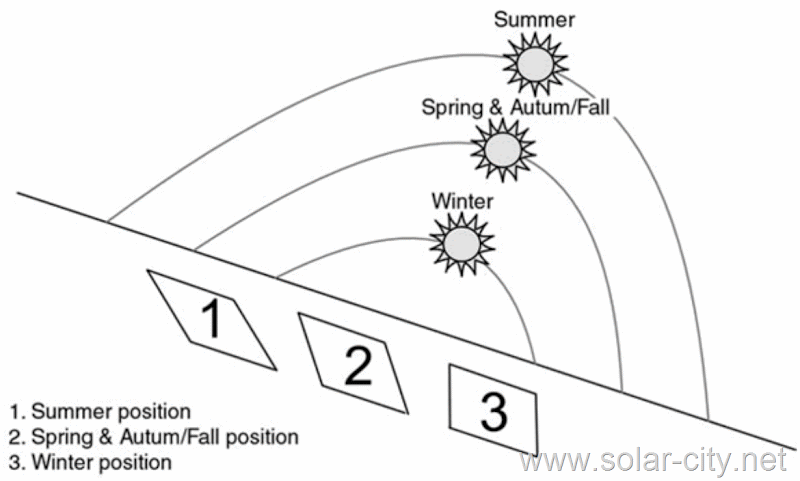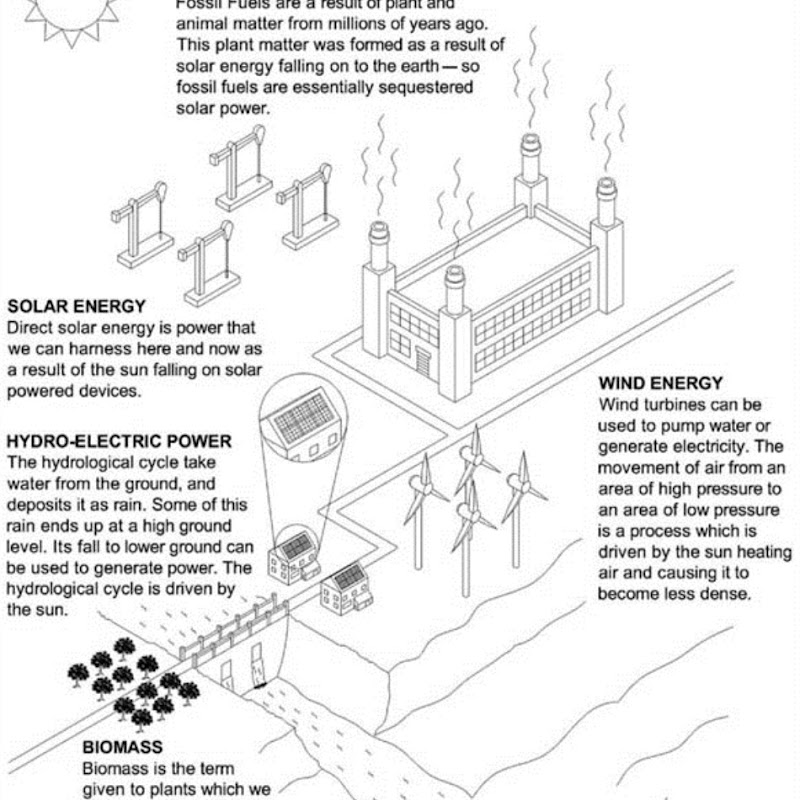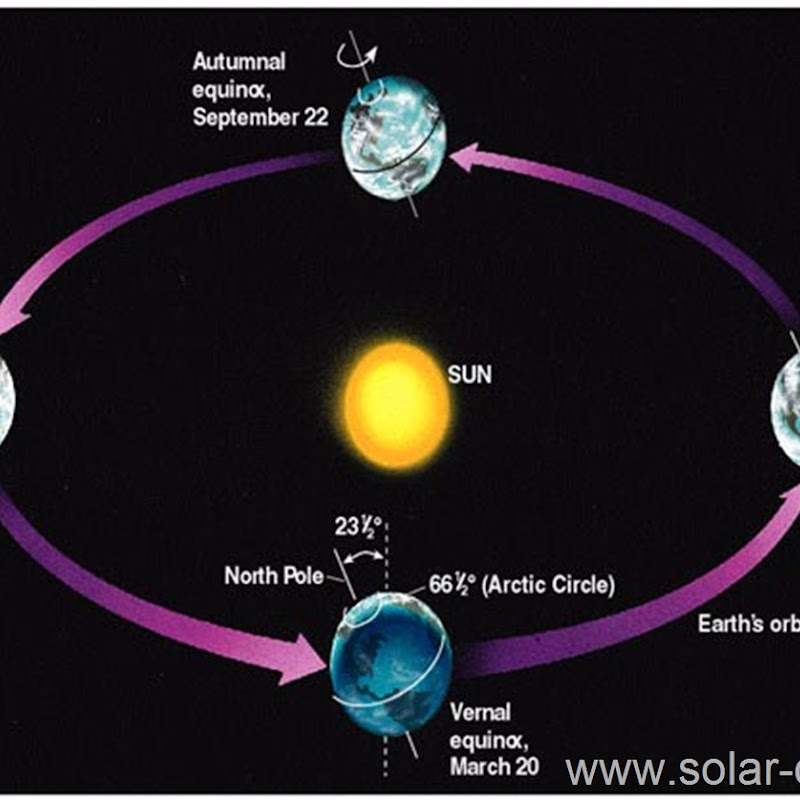The seasons
We have seen before what goes on at the sun as a source of our energy, we now need to explore what happens after that solar energy travels all the way through space to reach the earth’s orbit and see these solar energy facts.
Outside the earth’s atmosphere, at any given point in space, the energy given off by the sun (insolation) is nearly constant. On earth, however, that situation changes as a result of:
● The earth changing position in space
● The earth rotating
● The earth’s atmosphere (gases, clouds, and dust)
The gases in the atmosphere remain relatively stable. In recent years, with the amount of pollution in the air, we have noticed a phenomenon known as global dimming, where the particulate matter resulting from fossil fuels, prevents a small fraction of the sun’s energy from reaching our solar city (the earth).
Clouds are largely transient, and pass from place to place casting shadows on the earth.
In most places on Earth, the weather changes with the seasons. We generally associate winter with cold, ice, and snow. We think of showers, green grass, and new flowers when we think of spring. Summer brings to mind hot, humid, sunny weather. Autumn means falling leaves with cooler temperatures.
A season, then, is one of the four parts of the year (winter, spring, summer, and fall), each associated with a particular type of weather and happenings in nature.
Most of us have been comfortable with this knowledge since we were very young.
We’ve observed it year after year. Why do we have the seasons?
To understand the reason for seasonal temperature differences, we must consider the following diagram. (See figure below for the seasons in the Northern hemisphere.)
Specifically, we must pay attention to the angle of the tilt of the Earth as it relates to the sun in each of the four seasons. It helps to start with this information: The Earth’s axis is not sitting perfectly vertical. That is, if the Earth was a big, fat, juicy apple and you stuck a popsicle stick (axis) through its South Pole and passed it up through its North Pole, it wouldn’t sit flat. It would lean over. The amount it would lean is 23.5 degrees from vertical. Our big, fat, juicy Earth is leaning 23.5 degrees from vertical, too, regardless of the season. What changes from one season to the next is not the amount or the direction the Earth is tilted, but the orientation of the Earth’s tilt with respect to the sun.
 -->Look at the diagram again. Notice that the Earth is spinning on its axis. (our solar city is spinning on its axis.) making rotational movement. It has nothing to do with the seasons, but makes a night and day difference in our lives! When our part of the Earth rotates to face the sun (regardless of the season), it’s day. When we face away (again regardless of the season), it’s night.
-->Look at the diagram again. Notice that the Earth is spinning on its axis. (our solar city is spinning on its axis.) making rotational movement. It has nothing to do with the seasons, but makes a night and day difference in our lives! When our part of the Earth rotates to face the sun (regardless of the season), it’s day. When we face away (again regardless of the season), it’s night.
Getting back to the cause for the seasons, we now know what the reason for the seasons isn’t the rotation of the Earth on its axis. And it’s not the tilt of the Earth by itself; the Earth tilts 23.5 degrees from vertical all the time. Look at the diagram again. Notice that as we go from one season to the next, the Earth revolves around the sun.
It makes one complete revolution around the sun in one year, actually in 365 1/4 days and 8 minutes .
.
Viewed from upper Figure, this path makes a circle.
It’s when we combine the ideas of axial tilt and one complete revolution around the sun that things get interesting. They get interesting because the end result is that during one season the Earth leans toward the sun, during one season the Earth leans away from the sun, and during two seasons the Earth leans neither toward nor away from the sun.
Assuming you live in the Northern hemisphere. ( I think most of us do . Tell us if you don’t.)
. Tell us if you don’t.)
The season when the Earth leans toward the sun is Summer.
The season when the Earth leans away from the sun is Winter.
The seasons when the Earth leans neither toward nor away from the sun are Spring and Fall.
Check out the diagram one more time. When the Earth tilts towards the sun, the Earth receives the sun’s most direct rays. What does that mean for us? Have you ever been riding in the car on a long trip when the passengers in the car start to argue about how cool the air conditioner should be? The passengers sitting in the “sunny” parts of the car--where the sun’s rays are the most direct--are HOT. They want the AC cranked. Those who are sitting where the sun’s rays are not as direct want it a little warmer. It’s the same with the seasons. During the season when our part of the solar city (Earth ) tilts towards the sun, the sun’s rays strike us most directly and we’re hot. (There are also more hours of daylight, which means more time for our part of the planet to absorb solar energy, which again means hot.)
) tilts towards the sun, the sun’s rays strike us most directly and we’re hot. (There are also more hours of daylight, which means more time for our part of the planet to absorb solar energy, which again means hot.)
As a result of the sun appearing to be in a different place in the sky, we may need to move our solar devices to take account of this. Figure below shows how a flat plate collector may need to be moved at different times of the year to take account of the change in the sun’s position in order to harness energy effectively.

Outside the earth’s atmosphere, at any given point in space, the energy given off by the sun (insolation) is nearly constant. On earth, however, that situation changes as a result of:
● The earth changing position in space
● The earth rotating
● The earth’s atmosphere (gases, clouds, and dust)
The gases in the atmosphere remain relatively stable. In recent years, with the amount of pollution in the air, we have noticed a phenomenon known as global dimming, where the particulate matter resulting from fossil fuels, prevents a small fraction of the sun’s energy from reaching our solar city (the earth).
Clouds are largely transient, and pass from place to place casting shadows on the earth.
In most places on Earth, the weather changes with the seasons. We generally associate winter with cold, ice, and snow. We think of showers, green grass, and new flowers when we think of spring. Summer brings to mind hot, humid, sunny weather. Autumn means falling leaves with cooler temperatures.
A season, then, is one of the four parts of the year (winter, spring, summer, and fall), each associated with a particular type of weather and happenings in nature.
Most of us have been comfortable with this knowledge since we were very young.
We’ve observed it year after year. Why do we have the seasons?
To understand the reason for seasonal temperature differences, we must consider the following diagram. (See figure below for the seasons in the Northern hemisphere.)
Specifically, we must pay attention to the angle of the tilt of the Earth as it relates to the sun in each of the four seasons. It helps to start with this information: The Earth’s axis is not sitting perfectly vertical. That is, if the Earth was a big, fat, juicy apple and you stuck a popsicle stick (axis) through its South Pole and passed it up through its North Pole, it wouldn’t sit flat. It would lean over. The amount it would lean is 23.5 degrees from vertical. Our big, fat, juicy Earth is leaning 23.5 degrees from vertical, too, regardless of the season. What changes from one season to the next is not the amount or the direction the Earth is tilted, but the orientation of the Earth’s tilt with respect to the sun.

Getting back to the cause for the seasons, we now know what the reason for the seasons isn’t the rotation of the Earth on its axis. And it’s not the tilt of the Earth by itself; the Earth tilts 23.5 degrees from vertical all the time. Look at the diagram again. Notice that as we go from one season to the next, the Earth revolves around the sun.
It makes one complete revolution around the sun in one year, actually in 365 1/4 days and 8 minutes
Viewed from upper Figure, this path makes a circle.
It’s when we combine the ideas of axial tilt and one complete revolution around the sun that things get interesting. They get interesting because the end result is that during one season the Earth leans toward the sun, during one season the Earth leans away from the sun, and during two seasons the Earth leans neither toward nor away from the sun.
Assuming you live in the Northern hemisphere. ( I think most of us do
The season when the Earth leans toward the sun is Summer.
The season when the Earth leans away from the sun is Winter.
The seasons when the Earth leans neither toward nor away from the sun are Spring and Fall.
Check out the diagram one more time. When the Earth tilts towards the sun, the Earth receives the sun’s most direct rays. What does that mean for us? Have you ever been riding in the car on a long trip when the passengers in the car start to argue about how cool the air conditioner should be? The passengers sitting in the “sunny” parts of the car--where the sun’s rays are the most direct--are HOT. They want the AC cranked. Those who are sitting where the sun’s rays are not as direct want it a little warmer. It’s the same with the seasons. During the season when our part of the solar city (Earth
As a result of the sun appearing to be in a different place in the sky, we may need to move our solar devices to take account of this. Figure below shows how a flat plate collector may need to be moved at different times of the year to take account of the change in the sun’s position in order to harness energy effectively.












0 التعليقات: